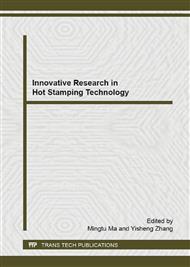[1]
J. W. Choi, H. H. Bok, F. Barlat, H. S. Son, D. J. Kim, M. G. Lee, Experimental and numerical analyses of hot stamped parts with tailored properties, ISIJ International 53 (2013) 1047-1056.
DOI: 10.2355/isijinternational.53.1047
Google Scholar
[2]
M. V. Li, D. V. Niebuhr, L. L. Meekisho, D. G. A. Atteridge, Computational model for the prediction of steel hardenability, metallurgical and materials transactions 29B (1998) 661-672.
DOI: 10.1007/s11663-998-0101-3
Google Scholar
[3]
D. P. Koistinen, R. E. Marburger, A general equation prescribing the extent of the austenite−martensite transformation in pure iron−carbon alloys and plain carbon steels, Acta Metallurgica 7 (1959) 59-60.
DOI: 10.1016/0001-6160(59)90170-1
Google Scholar
[4]
H. H. Bok, J. W. Choi, F. Barlat, D. W. Suh, M. G. Lee, Thermo-mechanical-metallurgical modeling for hot-press forming in consideration of the prior austenite deformation effect, Int. J. Plast 58 (2014) 154-183.
DOI: 10.1016/j.ijplas.2013.12.002
Google Scholar
[5]
A. Jablonka, K. Harste, K. Schwerdtfeger, Thermomechanical properties of iron and iron-carbon alloys: density and thermal contraction, Steel Res. 62 (1991) 24-43.
DOI: 10.1002/srin.199101722
Google Scholar
[6]
J. B. Leblond, J. Devaux, J. C. Devaux, Mathematical modeling of transformation plasticity in steels: I. Case of ideal-plastic phases, Int. J. Plast 5 (1989) 551-572.
DOI: 10.1016/0749-6419(89)90001-6
Google Scholar
[7]
J. C. Simo, M. Ortiz, A unified approach to finite deformation elastoplastic analysis based on the use of hyperelastic constitutive equations, Comput. Methods Appl. Mech. Eng. 49 (1985) 221-245.
DOI: 10.1016/0045-7825(85)90061-1
Google Scholar


